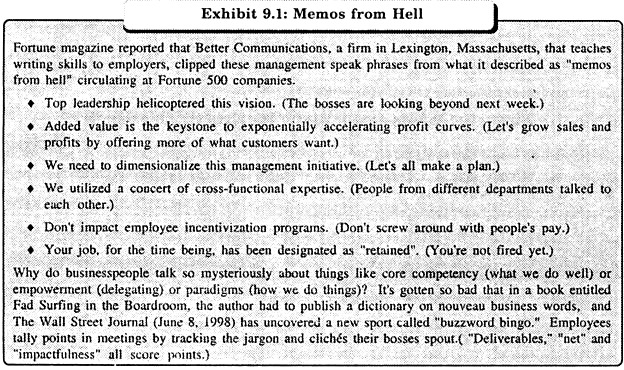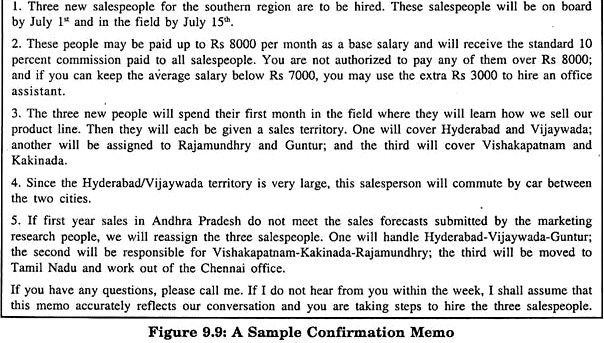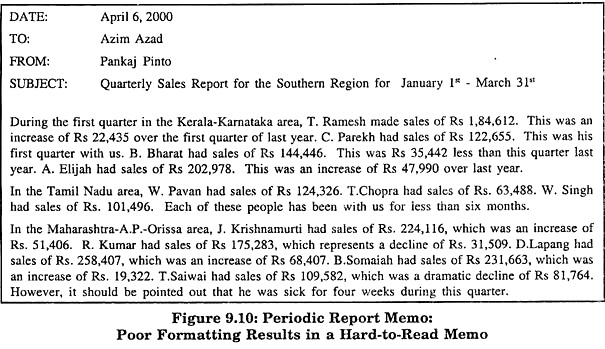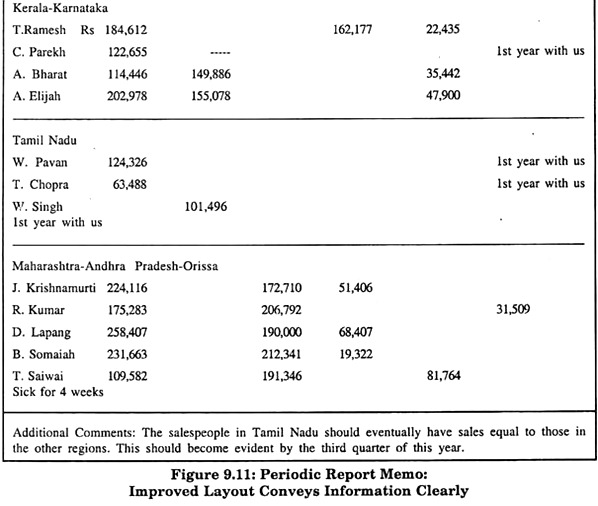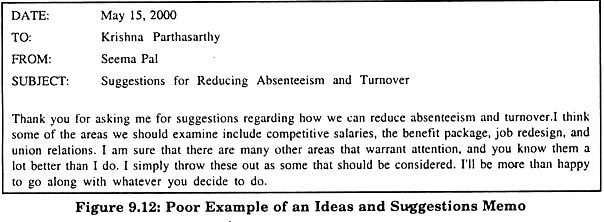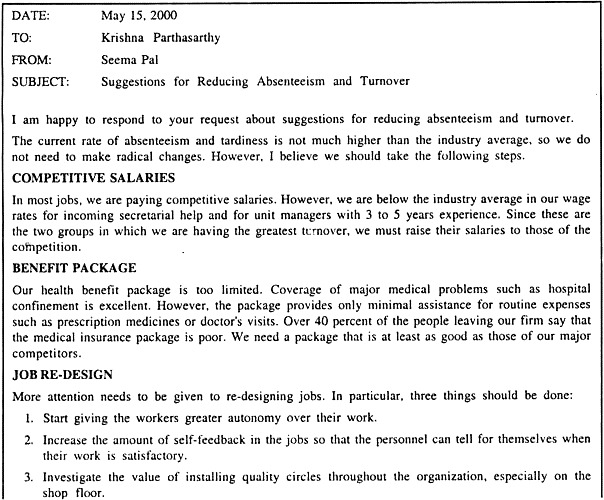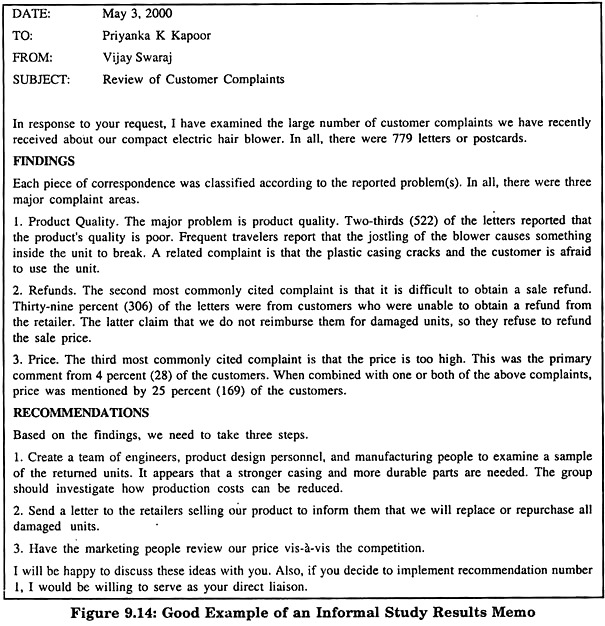This article throws light upon the five main types of memos. The types are: 1. Request Memo 2. Confirmation Memo 3. Periodic Report Memo 4. Ideas and Suggestions Memo 5. Informal Study Results Memo.
Type # 1. Request Memo:
The objective of a request memo is to gain a favorable response to a request. The memo must be written in a convincing way. Consider the following case: Hirdesh.
Humayun would like to attend a time management training program that will be sponsored by the chamber of commerce at a local hotel. The manager has asked Hirdesh to put his request in writing. Figure 9.7 depicts Hirdesh’s memo.
The memo is direct and clear, but not suitable from the reader’s point of view. As a result it may even fail to achieve its objective. Consider the manager’s situation. If many of the departmental personnel make a similar request, the manager may have to limit the number who can attend.
To achieve its objective, Hirdesh’s memo will have to be like a sales message (recall our discussion in Chapter 8). The request should be clearly stated. The memo should motivate the reader to take the desired action. The guidelines given below should be followed:
a. The request should be clearly stated
b. The reasons for the request should be presented.
c. If any financial costs are involved, they should be explained.
d. All expenses should be justified.
e. Recommendations for action should be presented.
f. Throughout the memo tact and diplomacy should be used.
If the memo is persuasively written, it should be easy for the reader to say “yes.” Following these six guidelines, Hirdesh’s memo has been improved – see Figure 9.8. Notice the difference between the first and second drafts of the memo.
The second version reminds the reader of a previous conversation during which the seminar was discussed. This serves as an introduction to the main memo. The reasons are then presented persuasively – showing indirect and direct benefits to the company (i.e., reader oriented). Finally, there is a request for action.
Type # 2. Confirmation Memo:
A confirmation memo is designed to confirm in writing something that has been agreed to verbally. Consider, for example, the sales manager who promises to provide sales coverage to six more cities if the general manager provides him with three additional salespeople.
When the general manager and the sales manager agree on this plan of action, it is common to find the general manager confirming this agreement with a memo.
In such cases, three important guidelines should be followed for writing the memo:
a. Be specific regarding the major points that were discussed and verbally agreed upon.
b. Enumerate the major points to emphasize them and allow easy reference to them in future discussions.
c. Encourage feedback on any misunderstood or unclear points.
Figure 9.9 depicts a confirmation memo about hiring new salespeople.
This message follows the three guidelines for confirmation memos. In this memo Krishna Murli first raises the major points that were previously discussed and agreed upon. Then he outlines the five major points he wants his sales manager to understand. By numbering them, Krishna ensures that all of them are equally emphasized. Finally, he gives Narayan Murthy the opportunity to ask questions.
Type # 3. Periodic Report Memo:
Periodic report memos – monthly cost control reports, quarterly sales reports – are submitted at regular intervals.
Since these memos are written frequently, they are designed and preprinted so that the writer can complete them quickly.
There are three helpful guidelines for constructing a periodic report memo:
a. The memo should be designed as a fill-in form on which data can be entered quickly.
b. The form should be designed so that it can be duplicated and re-used.
c. If narrative or descriptive commentary is necessary, a place should be provided on the form.
The value of a periodic memo is best illustrated with a comparison. Take a look at the memo in Figure 9.10 and then see how the readability and comprehension is improved by the style used in Figure 9.11.
The memo in Figure 9.10 is difficult to read, grasp and make comparisons. But the report memo in Figure 9.11 is concise, comprehensive and easy to understand. And every quarter all that the manager has to do is to enter the relevant data.
Type # 4. Ideas and Suggestions Memo:
Sometimes memos are used to convey ideas or suggestions. Very often managers ask subordinates for suggestions for tackling certain problems. In such instances, an ideas and suggestions memo is required.
Follow the guidelines listed below for writing this type of memo:
Write directly – the manager would not have asked for ideas unless he thought the writer had something to offer.
a. Begin with positive comments about the current situation (no one likes to be shot down), and then tactfully present suggestions for change.
b. Group ideas according to subject and use headings to highlight them.
c. Be specific and don’t stray off the point.
Read the memo in Figure 9.12 and identify its drawbacks.
What is wrong with this memo?
i. The writer is too general. She has not pointed out what the company should do to tackle its problems.
ii. She is more concerned with keeping her boss happy than with presenting useful suggestions.
Now read the memo in figure 9.13 and see how powerful it is.
Much better, isn’t it? The opening paragraphs define the problem tactfully. The recommendations are grouped by headings, and each is carefully explained. The conclusion is action oriented. The writer indicates how the recommendations can be implemented.
Type # 5. Informal Study Results Memo:
Organizational personnel are sometimes asked to write the results of an informal study in a memo. The objective of the message is to present the information in an easy-to-read, understandable form. To this end, follow the guidelines listed below:
a. State the purpose at the beginning (and stick to it).
b. Use headings and sub-headings to make the reading as easy as possible. Present data in a “Findings” section and interpret it in another called “Conclusions” (or other similar terms).
c. Be specific. Stay on the point and address different issues one by one, systematically.
d. Unless there is good reason to do otherwise, write the memo in informal language and use personal pronouns.
The memo in Figure 9.14 is an example of an informal study results memo that was written in response to a request from a top manager.
The opening paragraph states the purpose of the memo; headings and sub-headings act as signposts for the reader. Specific numbered points make the memo easy to read and understand.
